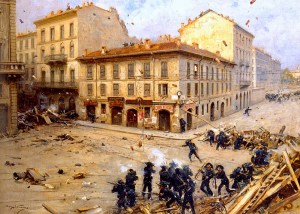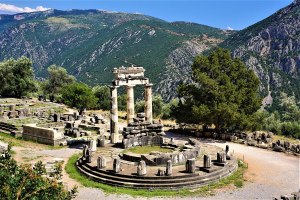We support our Publishers and Content Creators. You can view this story on their website by CLICKING HERE.
Christopher Nolan’s rightly celebrated movie is not what you expect to see. It uses the life and times of the father of the atomic bomb to denounce a world made wretched by the lack of truth. And T.S. Eliot becomes a seer of hope, prophesying that, before the nuke-metaphor explodes, there is still a chance for redemption.
God is dead, and for a while now even Woody Allen has been saying he doesn’t feel so good. But the dead god is neither the god of philosophers nor the God of believers. When, in his “The Gay Science” (1882), he wrote “Gott ist tot! Gott bleibt tot!”, Friedrich Nietzsche (1844-1900) had in fact already gone beyond. Beyond God? Yes, by killing the category of truth, without which God is no longer even thinkable. Postmodernist guru Gianni Vattimo (1936-2023), who is also dead, knew this well. Vattimo is considered the Italian philosopher who has been most translated abroad. The initiator of the school of the so-called “pensiero debole”‒literally “weak through”‒, his vision can be synthetized in the claim that human reason is structurally not able of any affirmation of meaning or value.
Recently, Vattimo died. With due respect to the dead (for the worship of the dead is one of the stigmata of man’s non-beastliness), but without even incensing a man merely because he is dead, Vattimo could only die. God died, and Vattimo threw a fistful of dirt on it. Truth is dead, and Vattimo buried it. How then to survive further? Vattimo’s death stands to the death of truth as Nietzsche’s physical-intellectual madness stands to the unbearable heaviness of modern speculation, along a parabola that from Nominalism ends in embracing the German philosopher’s horse. (An often-told tale recounts that, in Turin, Italy, on January 3, 1889, Nietzsche, out of a sudden demented compassion, rushed his arms around the neck of a horse that he had seen being flogged. It was the first evident sign of the mental breakdown that eventually killed the philosopher of irrationalism on August 25, 1900.)
Going to the cinema
The fullest representation of all this is depicted in Christopher Nolan’s movie Oppenheimer—a most celebrated film, and rightly so, but for the wrong reasons. The viewer, even the critic, think to enter a theater to watch the biopic of the father of the atomic bomb, to witness a film—trial against nuclear power and war, even to hear straight words on McCarthyism (which was anyway abundantly right). Not at all. With Oppenheimer, Julius Robert Oppenheimer (1904-1967) and atomic mushrooms have nothing to do. In fact, the actors performing—at their highest—in the movie to be symphonically orchestrated by the director, move within William Shakespeare’s (1564-1616) most overused and worn, and perhaps least understood, phrase: “All the world’s a stage.” That of Shakespeare in his 1623 pastoral comedy “As you like it” (Act II Scene VII, Line 13) can be regarded as a palindrome-style sentence, where words read the same backwards as forwards: it in fact also says that a stage is all the world. Everyone who writes, exploits. Plato exploited the character of Socrates, certainly not to shorthand his wisdom. Shakespeare exploited Julius Caesar, and all the Henries and all the Richards of his historical plays, certainly not to jot down their biographies. Nolan does it with Oppenheimer for analogous reasons.
One day the British filmmaker came across a book, “American Prometheus: The Triumph and Tragedy of J. Robert Oppenheimer.” It was published in 2005 by Kai Bird and Martin J. Sherwin, and earned his authors the Pulitzer Prize for biographies the following year. Messing with Prometheus to address the atomic bomb title is only a seemingly platitude. In Nolan’s imagination, that character from ancient Greek mythology becomes a strong allusion which is featured in the film’s initial scene. Being identical to the last (and possibly thus suggesting an idea of the eternal, or just of the unfinished or cyclical, given also the movie’s nods to Eastern cultures), those opening Promethean frames of massive explosions and big fires are the hook that pulls the viewer into the story.
The most classical version of Prometheus’ tale is told in the late 8th-century BC “Theogony” by Greek poet Hesiod. Because of Marxists, it is also the most misunderstood of all Greek myths. Like the Thracian slave Spartacus (c. 103–71 BC)—who revolted against the Roman Republic, was slain and later was transformed into an improbable class warfare hero by the German communists in World War I—Prometheus is normally bequeathed to us as a Nietzscheansque superman who challenged the jealous Olympian gods to gain (or gain back) knowledge and technology (symbolized by fire) to dispossessed human beings, vindicating earthly freedom against the tyrannical divine. But truly Prometheus was just a disobedient to the supreme divine law, not unlikely Adam and Eve, whose sin is certainly not having stolen a piece of fruit from a miserly peasant.
Poetry as a messenger
Now, in Bird and Sherwin’s book Nolan finds T.S. Eliot (1888-1965). Eliot again‒as he is so fully present also in Nolan’s 2020 film “Tenet,” a literally palindromic title in its turn. Let me deal with this for half a minute. In “Tenet,” Eliot crosses over (not a casual expression) to the sublime mystery of the so-called “Sator Square.” Beginning from Roman-era sites, and spreading throughout the Middle Ages, it is a square made of palindromic words: “sator,” “arepo,” “tenet,” “rotas,” and “opera.” Their meaning has been variously reconstructed but never to the level of certitude. Speculations also see it containing a Christian message in disguise, even a prayer, maybe hidden at first during Roman persecutions. Be that as it may, the center and core of the “Sator Square” is the word “tenet” shaped as a palindromic, or all-directions, cross that sustains the other words and the whole enigma. In Latin, “tenet” is the third singular person of the verb “to bear,” “to carry,” “to hold up.” It also holds up the plot of Nolan’s 2020 movie since its title, whereas in the film “sator,” “arepo,” “rotas,” and “opera” become name of characters, companies, and places.
Well, Nolan seems to be unable to shake Eliot off his shoulders. Enormous must have been his surprise when in Bird and Sherwin’s book Nolan discovered that Eliot’s poetry was among Oppenheimer’s favorite, especially The Waste Land (1922). A scene in the movie features the American scientist reading from it.
“The Wast Land” is a rich title, and sadly often poorly translated in foreign languages‒for example in my own Italian. Eliot’s waste land is in fact “la terre gaste” of the “matter of Britain” and other Arthurian romances of Medieval France. (Modern English word “waste” comes indeed from Old French). By way of troubadour route, that expression reached Dante Alighieri’s (1265–1321) “Divine Comedy” where it becomes “un paese guasto,” literally “a broken land” (“Inferno,” XIV, 94). The classical translation of Dante in English by Henry Wadsworth Longfellow (1807–1882) renders it as “wasted land.” In Modern English, Dantes’s adjective “guasto” has sound resemblance to the adjective (and adverb) “ghastly,” coming from Old English and related to “ghostly,” as in a horrific vision of a specter. Eliot’s “waste land” is in fact Dante’s “country gone to ruin,” wretched and corrupt, only seemingly alive but really approaching final death, a phantom of what once it was. Ominous and “omenous,” frightful and doomed.
Indeed, the unfruitful and dried up Dantesque moor of Eliot’s The Waste Land is modernity withering away for not being able to recover the truth of the Holy Grail any longer. Oppenheimer and Vattimo meet in this desert—the desert of Los Alamos.
True lies
No biography, in short, nor an historical film. Nolan stands to Oppenheimer as Hamlet stands to the prince of Saxo Grammaticus’ “Gesta Danorum” or to Macbeth, King Lear, and Cymbeline of the “Holinshed’s Chronicles” (1587) from which Shakespeare drew them. They are masks, i.e., personifications, as the Greek theater called them, moving on the proscenium of history. Occasions picked up by Nolan to write another Eliotian page of cinema, a storytelling and a symbol on the “empire at the end of its decadence,” as French poet Paul Verlaine (1844-1896) said in his poem “Langueur” (1883), the same Verlaine that Eliot quotes in his The Waste Land. This is how it is, if you like it, and this is how the world deprived of truth will end: Oppenheimer is just a verist fresco of this gigantic still life.
In fact, everyone in Nolan’s film lies and pretends. The protagonists of the Manhattan Project take a staged lie as true. Los Alamos in the New Mexico desert is a posturing city that tramples on the dead. Katherine Puening, or Mrs. Oppenheimer (1910-1972), lends herself to her husband’s double life. Politics knows no truth, science too, and President Harry Truman (1884–1972) lies knowing he is lying. As for politician Lewis Strauss (1896–1974), he is the great puppet master of yet another lie, as enormous and titanic as the atomic bomb itself, hatched against Oppenheimer. Yet also Oppenheimer is ambiguous, duplicitous, indecipherable. Only General Leslie Groves (1896–1970) and scientist David L. Hill (1919–2008) seem to open glimmers of truth, but the illusion is short-lived. During a private hearing, orchestrated by Strauss, then of course full of lies, Groves seems to bring light into this total darkness. He candidly confesses that, in hindsight, he would not have granted Oppenheimer (more or less a Communist sympathizer) security clearance to handle classified information as instead did in the early days. But he immediately goes back into the relativist “dead canal” (as Longfellow translates “la morta gora” of Dante’s “Inferno,” VIII, 31), adding (while no one listens to him anymore) that he would not, however, have granted security clearance to anyone else in the Manhattan Project. And Hill, he who eventually scatters everything, wrecking Strauss’ faithless ministerial aspirations, returns yet another pawn of non-truth, contributing, by his own good deed, to the evil of creating the fake myth of a heroic Oppenheimer and a virtuous atomic bomb. Because, without truth, even good produces evil.
After all, the whole bomb affair of Nolan’s movie is an absurd gamble, a bet, a leap into the void. It could set the world on fire, aping God. Oppenheimer christens the detonation of the first atomic device, blasted in the New Mexico desert on July 16, 1945, “Trinity” from the Holy Sonnets (1633), No. 14, by the English metaphysical poet John Donne (1572-1631)‒the poet that Eliot prefers and Oppenheimer loves. For Oppenheimer is tormented by God, but he chooses Prometheus.
Enters God
Oppenheimer is also attracted to that complex of beliefs and rituals that Westerners call Hinduism and its practioners Sanātanadharma‒ponderously though, using the scales of a self-styled scientist such as Don Ferrante in Alessandro Manzoni’s (1785–1873) “The Betrothed” (1827, rewritten 1840-1842), a petty martyr of futile knowledge who was unable of spiritual generosity, cultural foresight, and moral heroism. Oppenheimer reads Sanskrit and from the sacred text of the “Bhagavadgītā” extracts a phrase that, in a documentary broadcasted by NBC in 1965, he recalled having uttered in front of the experimental deflagration: “I am become death, the destroyer of worlds.” This is Oppenheimer’s translation, though; the original in the “Bhagavadgītā” says: “Time I am, destroyer of the worlds,” and he who speaks these words is, the monotheistic “Bhagavadgītā” explains, “God, the Supreme Person.” Eliot was familiar with Hinduism‒thanks in part to his professor at Harvard, Irving Babbitt (1865-1933)‒and drew materials from it for The Waste Land. Whereas time is another Eliotian truth, that betrayed translation is another Oppenheimerian mystification. In Nolan’s movie, the phrase from “Bhagavadgītā” is also superimposed on a sexual intercourse between the father of the atomic bomb and his Communist mistress, Jean Tatlock (1914-1944), in an all too obvious allusion to the perverse marriage of Eros and Thanatos, which terrified Eliot. Eventually, Tatlock, depressed and abandoned, will commit suicide. Its is really the waste land.
The final scene in the film, which repeats the initial one, both canceling and extending time, is the possible explosion of a world devastated by the most terrible nuclear devices that one can ever imagine, a metaphor of how the world without truth undoubtedly ends. The bombshell, the news-bomb is that there is no hope in a world with neither truth nor a desire for it. In fact, in a special show by the cultural service of RAI, the Italian state tv paid by Italian citizens, philosopher Vattimo taught that even asking what truth is is a wrong question.
Yet the Eliot of “Tenet” and Oppenheimer, which constantly wonders on time (history) as a possibility for truth (a hard sense beyond time the devourer,) always returns to tell us, as in “Ash Wednesday” (1930), that no, it hasn’t happened‒yet. That, serving truth, one can still “redeem the time.”
The Imaginative Conservative applies the principle of appreciation to the discussion of culture and politics—we approach dialogue with magnanimity rather than with mere civility. Will you help us remain a refreshing oasis in the increasingly contentious arena of modern discourse? Please consider donating now.
The featured image is courtesy of IMDb.

 Conservative
Conservative  Search
Search Trending
Trending Current News
Current News 






